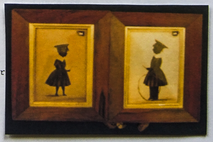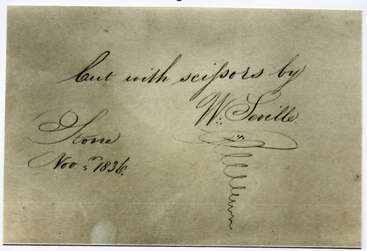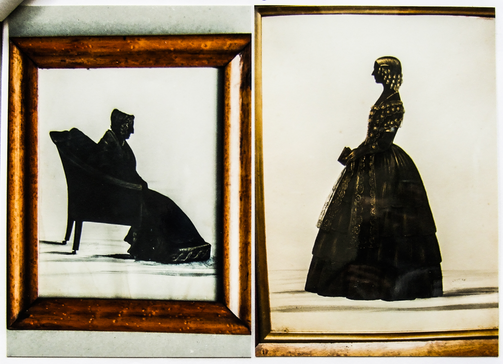Seville, W. and Son (SCC Newsletter March 2000)
W. and Son Seville
A MINOR ARTIST WORTH ATTENTION !
 This article is some attempt to look at the 'material' we have so far on Mr. Seville and his work. As a result I hope that Members who have silhouettes by him will let me know in the hope that these can be reproduced in a future Newsletter to add to our knowledge of his range of work.
This article is some attempt to look at the 'material' we have so far on Mr. Seville and his work. As a result I hope that Members who have silhouettes by him will let me know in the hope that these can be reproduced in a future Newsletter to add to our knowledge of his range of work.
1. Background. Unfortunately Mrs. McKechnie was unable to obtain any background information from parish records, rate books or other official documents as to where Mr. Seville lived or any other family or person details. Even his initials are not certain - F. W. has been used but it is now accepted that thathe was simply W. Seville. It is known that he had a son, who is likely to have worked with him - but no further details are known in regard to the 'partnership'. Therefore information had to be obtained from his newspaper advertisement published in the towns he visited and his handbills.
2. Literature. There are only brief entries on this artist in British Silhouettes by John Woodiwiss, Arthur Mayne's British Profile Miniaturists and in the Art of Silhouette by Desmond Coke. All three did not regard Mr. Seville very highly! Woodiwiss described him as "a skillful cutter" but felt that gold embellishment was his undoing! Arthur Mayne had a very small entry on him remarking "he was clearly popular since his shades appear quite often". Darning with faint praise I think! Desmond Coke states that "F. W. Seville cleverly staked out a claim on Shrewsbury and the Midland Schools/where he adorned prim-looking scholars with unconvincing gold." (I have not see a scholar by him so far.) Mrs. Jackson had a larger entry in her Dictionary giving a few more details about the places he visited and the charges he
MR. SEVILLE — Page 2.
made. Mrs. McKechnie worked hard to gather more facts -particularily in regard to his labels and the towns he visited and some dates. She did not comment greatly on the quality of his work but did suggest that the better gilding on his work might have been done by his son!
3. General. Seville was obviously an itinerant artist. At one point it was thought that he might have had a base in Manchester - but not so it seems. He is known to have visited Manchester in 1818, Lancaster, Newcastle-on-Tyne, North Shields and East Anglia in the 1820's. He possibly visited Scotland (Edinburgh & Glasgow) in 1825 - Dublin in 1830 and other parts of Ireland in the early 1840's (Drogheda) and Shrewsbury in 1845. He does not seem to have visited the South of England at all.
4. His Work. It is evident that Seville’s skills were in his cutting. His plain black bust-length silhouettes have been illustrated and recorded by Mrs. McKechnie in her entry on pages 269-271. His bust-line terminations are of the convexity and concavity type - extruding to some length in the front. He also cut full-length plain black silhouettes - these were equally competent but I think would be difficult to attribute without a label or an inscription. However, Mr. Seville is best known to collectors for his full-length gilded figures of children often dressed in tasselled caps and wide white lace collars - often holding a whip/hoop or some other toy (even a toy rifle in one work!) Usually the gilding is fairly cursory -sometimes more detailed.The foreground is painted with thinned watercolour -showing shadow lines but little else.The base colour of the figure can be black or often a dark grey. These works are usually housed in bird's eye maple frames or rosewood with a gilt inset. The little girls often seem to be standing on rather spindly legs - the boys are spared as they wear trousers! I have illustrated on this page two photographs of this type of work - these are in the Malahide Castle Collection near Dublin. (apologies for the quality but the photos were taken several years ago under difficult conditions!)
 Although we are familiar with his children it seems Mr. Seville was prepared to tackle any 'subject' - infants in their mothers' arms, officers in uniform, elegant young women holding books or playing the harp, elderly ladies sitting in their armchairs, over-weight gentlemen holding their top hats and finally dogs & horses with or without their owners! I have illustrated some examples in this article, which I will describe later.
Although we are familiar with his children it seems Mr. Seville was prepared to tackle any 'subject' - infants in their mothers' arms, officers in uniform, elegant young women holding books or playing the harp, elderly ladies sitting in their armchairs, over-weight gentlemen holding their top hats and finally dogs & horses with or without their owners! I have illustrated some examples in this article, which I will describe later.
Mrs. McKechnie has an entry in the painted section of her Book - he is said to have attempted to paint silhouettes early in his career, but there are no extant examples and clearly this was not his medium. There is also an entry on the section in the Book where artists delineate their sitters' features. For this type of work Seville employed other artists. There is a reference to a Mr. Stannard in one of his advertisement, who may have done this work.
5. Labels. Eight trade labels are known. Most are very short simple little labels just stating "Mr. W. Seville". No prices are given or dates - so it is not possible to put the labels in any sort of date order. Some of the labels were extremely small i.e. ¾" X 1¼". He varied the colour of the label using, orange, bright yellow, green, pink & brown. Some labels stated "Cut with Common Scissors by Mr. W. Seville. In his later work he used a stencil on the obverse of the silhouette. He also used handwritten inscriptions - I have illustrated one of these in this article. These were possibly written by his son. I think Seville's labels are rather vital for the attribution of his work as his style is not always easy to recognise. No doubt many of these little labels have been lost or dicarded over the years.
MR. SEVILLE — Page 3
 The inscription above is from the back of the portly gentleman illustrated at the beginning of this article. It was written in Stone (Staffordshire) - another place visited by Mr. Seville and/or his son.
The inscription above is from the back of the portly gentleman illustrated at the beginning of this article. It was written in Stone (Staffordshire) - another place visited by Mr. Seville and/or his son.
6. Advertisements and handbills. Seville seems to have favoured very large and somewhat grand advertisements. Often he used the SAVILLE coat of arms on these - whether he claimed kinship in spite of the difference in spelling is not clear. Whatever the facts he obviously felt that it improved his chances of attracting customers! Mrs. Jackson in her Dictionary quotes one of these and I think it is worth quoting this in full. (any underlying is mine) :- "Striking Likenesses cut with Common Scissors in a few seconds without either Drawing or Machine or any other aid, but by a mere glance of the Eye by Mr. Seville. Full length Figures, Animals etc. etc. cut in any attitude. Profiles faithfully copied, Plain Bust 1s. Two of the same Person 1s. 6d. Elegantly Bronzed 1s each extra. Frames in great variety on Sale. Attendance from 11 till 1 from 3 till 5 and from 6 till 9 i'clock. Families attended. One shilling full length 5s or two of the same 6s.6d." This advertisement seems to have been used from 1820's as he was charging the same prices when in Newcastle-on-Tyne in 1824 - although by then he had added dogs at 3s. 6d to his price list.The price for dogs went up to 5s a few years later! So dogs were quite pricey - no doubt he worked on the sentimentality of their owners!
7. Frames. He used papier mache frames for his plain black bust-length work, but later used rosewood frames with or without gold insets for these as well as his bronzed work bust or full length. On the other hand I have seen his work in plain gilt frames and narrow ebonised frames with gilt insets - also in bird's eye maple. I think it is possible that his silhouettes could be found in almost any type of frame. The sizes of his figures vary and some are framed with plenty of space around to give a 'better' effect. In the Andrew's Collection at Stoner House one frame is 23 X 35 cms and another is 16 X 20 cms.
8. Seville in the Salerooms. A number of works by Seville have been sold in the major London Salerooms in the past two years. There were two in the Harman Sale at Bonhams on 30th. June, 1998 - a full-length of a lady and a bust-length child. Three have appeared at Christie's South Ken. during 1998 - two of full-length gents holding top hats and one of a lady seated at a harp.
MR. SEVILLE — Page 4
 9. Illustrations of his work. At the beginning of this article I have illustrated two silhouettes by Mr. Seville. Firstly a rather portly middle-aged gent - I am afraid not all his gilding is shown in the photograph - however it is not very detailed. As I have mentioned the inscription from Stone is on his back. Secondly a lady seated at a harp - she is nicely gilded although this is not all visibly in the photograph. Her harp is delicately drawn and painted. The cutting of the right hand separate from the body is unusual but effective. This is quite a large work - it is attractively framed and presented. I am grateful to a Member of the Club for an opportunity to photograph both these silhouettes from his Collection. On this page there are two further silhouettes by Mr. Seville. Firstly of an elderly lady sitting in a chair with her feet on a footstool. She has limited gilding which seems to have faded somewhat over the years. She is simply framed and it is just possible to see Seville's stencil just under her chair. She is illustrated in Mrs. McKechnie on page 341 illus. 583 and she is called Mrs. Stevenson. Secondly of a more glamorous young lady from the Andrew's Collection at Stoner House. She is skilfully gilded and I think it is possible to see this. She also has a stencil which can just be seen at the bottom of her skirt. I think she is a late work and may be the son is responsible for her! She is quite a large work and is housed in a rectangular frame - 27.5 cms.
9. Illustrations of his work. At the beginning of this article I have illustrated two silhouettes by Mr. Seville. Firstly a rather portly middle-aged gent - I am afraid not all his gilding is shown in the photograph - however it is not very detailed. As I have mentioned the inscription from Stone is on his back. Secondly a lady seated at a harp - she is nicely gilded although this is not all visibly in the photograph. Her harp is delicately drawn and painted. The cutting of the right hand separate from the body is unusual but effective. This is quite a large work - it is attractively framed and presented. I am grateful to a Member of the Club for an opportunity to photograph both these silhouettes from his Collection. On this page there are two further silhouettes by Mr. Seville. Firstly of an elderly lady sitting in a chair with her feet on a footstool. She has limited gilding which seems to have faded somewhat over the years. She is simply framed and it is just possible to see Seville's stencil just under her chair. She is illustrated in Mrs. McKechnie on page 341 illus. 583 and she is called Mrs. Stevenson. Secondly of a more glamorous young lady from the Andrew's Collection at Stoner House. She is skilfully gilded and I think it is possible to see this. She also has a stencil which can just be seen at the bottom of her skirt. I think she is a late work and may be the son is responsible for her! She is quite a large work and is housed in a rectangular frame - 27.5 cms.




